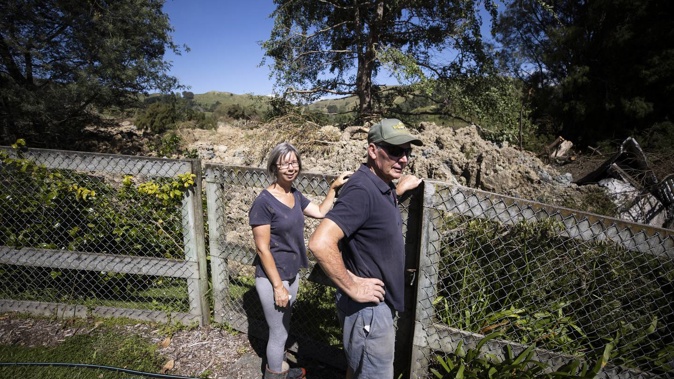
Eleven people died and many more lost everything they owned when Cyclone Gabrielle struck. A month on, the mop-up continues. The Herald on Sunday revisited people who are still out of their homes.
Northland was the first to feel the brute force of Cyclone Gabrielle - with the powerful winds and torrential rain downing powerlines and causing floods that swamped homes.
Next the storm - one of the fiercest to hit New Zealand - lashed Auckland, in the process causing a landslide at Muriwai which tragically killed two volunteer firemen.
For the next few days, it was the turn of regions such as Coromandel, Waikato, the East Coast and Hawke’s Bay to feel Gabrielle’s wrath.
Nine more people were to tragically die amid the natural disaster; the majority being in Hawke’s Bay, where walls of water, silt and mud buried countless houses and businesses.
A month on from when the cyclone first made its destructive presence felt, the scars in those regions are clear to be seen.
/cloudfront-ap-southeast-2.images.arcpublishing.com/nzme/6KZ4KCVLWBD2RBZNQGCTILSLEY.png)
Extraordinary destruction left by Cyclone Gabrielle on the East Coast. Photo / Supplied
Hills around Hawke’s Bay and the East Coast have been gouged at by large landslips. In both provinces, homeowners and volunteers are working tirelessly to try and free their homes and properties from the stinking layers of mud and silt - in some places up to 2m high.
The roading network has also been hammered; with bridges washed away and main routes - including state highways - in Coromandel, the East Coast and in Hawke’s Bay - still closed potentially for several months ahead.
And the scarring is ever-present on those who survived the weather battering; people who in the early morning hours feared they would lose their lives as they waited in trees and on roofs of houses amid sea-like flood waters for rescue.
Couple expect to be living in caravan for at least a year
As they barbecued their dinner, Gisborne homeowners Clive and Helen Foster could only stand and watch as the largest slip in the Gisborne district - spanning about 15 acres - slowly missed their home by a metre.
What was once a lime and mandarin orchard at their neighbour’s property is now a jagged undulating trough of massive rocks and light brown earth.
Although the slip missed their house, the Fosters’ homestead was slapped with a red sticker almost three weeks ago when a Gisborne District Council building inspector said it was “definitely” the largest slip from Cyclone Gabrielle in the Gisborne region.
The retired couple are now living in their caravan and have converted their garage into a lounge area.
A large slip came very close to Clive and Helen Foster's home on Taurau Valley Rd near Gisborne. Photo / George Heard
“It is a bit of a waiting game at the moment,” Helen says. “Until we get a GeoTech report back on the landslide and its safety, we don’t really know our next step.”
She understands it will take between four and six months to receive back the report.
“We are anticipating that we will be living like this in the caravan for at least a year before there are even talks about us getting back into the house.
“We enjoy caravaning, so it is a familiar experience for us, but I imagine it might be a bit of a different story in the winter,” she said.
Helen says the couple has had limited access to the house during daylight hours to gather all of their possessions and use the shower.
Remaining positive, Helen says there are a lot of people in worse situations who have lost everything, including loved ones.
“You can only be positive really, we just have to accept that these things happen ... At least we’ve got all our possessions and we have somewhere to stay,” she said.
The large slip has come very close to Clive and Helen Foster's home on Taurau Valley Rd. Photo / George Heard
The slip caused about $1 million worth of damage to the neighbouring farm.
The Fosters are mindful of the toll that shock and distress have had on them and are keeping a close eye on each other’s mental health.
“We have wonderful friends and neighbours who have been very helpful, but we understand that this process is going to take its time,” said Helen.
Helen says although the couple’s lives took a huge change three weeks ago, it is something they just have to live with.
“We just have to be mindful that it’s a huge disaster and that we have to wait our turn and we accept that,” she said.
- Benjamin Plummer
Couple to rebuild ruined home and business - somewhere else
Cyclone Gabrielle’s deadly wall of water, silt and mud didn’t just destroy Katrina and John Harris’ Esk Valley home - it also washed away the business they had painstakingly devoted the past three years to.
/cloudfront-ap-southeast-2.images.arcpublishing.com/nzme/MMUE4RFSVVE65CDL7VJRASKPVM.jpg)
Esk Valley residents Katrina and John Harris are lucky to be alive after their Esk Valley property was swamped by neck-deep water during Cyclone Gabrielle. Photo / Neil Reid
The Harris family was lucky to survive; as neck-high flood water surged through their house, they attempted to smash their way into the roof cavity.
They were eventually saved when a lounge wall “popped out”, allowing the water to escape.
For several days the family stayed at the Bay View Hotel and Holiday Park, where kind-hearted publican Adrienne Morrin transformed her lounge bar into a live-in evacuation centre for those who had been displaced.
Home now for the family who owned The Doggy Home Stay at Esk Valley is an Airbnb they have secured in Ahuriri until late 2023.
And while their previous home and doggy daycare buildings are wrecked, the generosity of customers and members of the Hawke’s Bay community is seeing the Harrises slowly get back on their feet.
The home of Esk Valley residents Katrina and John Harris. Photo / Supplied
Esk Valley might be drying out, but an aerial view of part of the area shows how much is left under mud and silt. Photo / Neil Reid
That includes being given a slice of land rent-free so they can resume their daycare business, a customer building them a sheltered area on it for the dogs, and other customers and community members launching a Givealittle to help them rebuild permanently somewhere else.
“It is happening too quickly for me,” Katrina laughed.
“These people, they are just incredible. I just can’t believe that people thought that much of us. We have a lovely place so we are happy.”
She doubts they will ever be allowed to rebuild on their Esk Valley land.
Given their insurance claim covers their house as well as the business and buildings associated with it, the process was “complex”.
Two days after their near-death experience, John Harris told the Herald how the flood waters were “hundreds of metres across the left of the house, and hundreds of metres across to the right of the house ... the whole valley was just one big river, massive swift and fast.
“And the roar of it [the water] ... it was like you were standing next to Huka Falls.
“It was terrifying. The volume of water was just horrendous.”
Like so many others impacted by Cyclone Gabrielle, the Harrises lived in a state of shock for some time.
Almost a month on, Katrina said the full reality of the situation had sunk in, bringing with it a raft of emotion.
“I look at it, and we worked so hard to get to where we were, and what a waste of time and energy,” she said.
“We worked seven days a week, for three years, never had holidays and time to spend with the kids to go on holiday ... and it is all wasted.
“That is what I am angry about. In a flash, it is all gone. But we have our lives.”
- Neil Reid
Cleared for rebuild
Cyclone Gabrielle survivor Willem Kupa has had no time – or inclination – to feel self-pity in the aftermath of the deadly storm.
Like many others living in the rural Hawke’s Bay settlement of Omahu, the Kupa family home was swamped by a neck-high flood of raging water, silt and mud.
Cyclone Gabrielle survivor Willem Kupa says he and his family are slowly rebuilding their lives after the storm trauma and damage. Photo / Neil Reid
He credits his survival last month – and that of his children aged 6, 5 and 3 - to the heroic actions of his father, Mare Kupa, who bravely drove through the inland swells in a tractor to retrieve them and get them to safety.
Willem Kupa later took charge of the tractor to rescue his neighbours.
While saving his neighbours he was confronted by the “devastating sight” of some of his stock drowning in front of him, including sheep snagged on farm fences.
The roads through Fernhill and Omahu are littered with piles of ruined household items after Cyclone Gabrielle. Photo / Neil Reid
Life over the past few weeks has involved stripping gib, flooring and household items from both his own house and others in the tight-knight Omahu and Fernhill communities.
In a community shared by so many other places hammered by Gabrielle, Kupa said.
“It is not just us as individuals who were affected,” he said. “It is pretty much our whole community.
“It shows just how strong our community can be. Helping one another is what it is all about.”
Kupa has been a regular visitor to Omahu Marae; the focal point for nearby communities where volunteer work teams are dispatched to help at properties.
The marae has also been providing free lunches and dinners and is distributing donated household items, toys, clothes and other items.
“The whānau who have been down at the marae doing all the support has been amazing,” he said.
“It has been a very big support for myself, my whānau, and a whole lot of other whānau. It makes life just that little bit easier, with that support.”
The family is currently staying at Kupa’s wife’s grandparents’ house.
He said their three young children had been incredibly “resilient” in the aftermath of the deadly natural disaster.
An apple crop near Omahu is among scores of fruit and vege land ruined by the mud and silt which flooded the area. Photo / Neil Reid
Priorities for him and his wife now were sorting out their damaged house, replacing written-off vehicles and repairing farm fences.
At this stage, the family house has been cleared to be rebuilt, with Kupa saying given what Omahu meant to him and his family he wouldn’t want to move elsewhere.
“I am happy to live back there. That is where I am from,” he said.
“It was a very unfortunate event and hopefully it doesn’t happen again.”
- Neil Reid
‘You have to have some sort of empathy’
To Michael Glazer’s “layman’s” eye, his Karekare home is undamaged and perfectly safe.
But the two-bedroom house, located near the breathtaking west coast Auckland beach, has been slapped with a red sticker and nearly a month on from Cyclone Gabrielle the property remains uninhabitable.
Drone view of properties on Karekare Rd, Karekare, West Auckland March 2023. The far left property is owned by Michael Glazer. Photo / Supplied
Glazer was at home when a huge chunk of hillside gave way and smashed into a pool at the rear of his property. Another slip knocked his neighbour’s house, which sits above Glazer’s, off its foundations.
The 55-year-old company director believes the threat posed by the damaged neighbouring house is the likely reason his own home has been ruled off-limits.
But he’s still trying to confirm why his house was assessed as unsafe to enter and when - if ever - he’ll be allowed to return.
Forced to stay with friends nearby, Glazer has been trying to reach his insurance company for answers but is yet to speak to a real person. The only information he’s received is that his claim is “in process” and he needs to await an EQC loss adjuster’s site visit.
His property is one of 10 slapped with red stickers across the devastated Karekare community, which remains cut off to the outside world after slips made roads connecting the settlement impassable.
While helicopters make daily welfare drops of food and other emergency provisions, Glazer says those still reeling from the storm remain in a state of limbo. They urgently need insurance assessors and geotech experts to visit Karekare to provide answers and certainty.
“All these stickered houses need to be assessed pretty quickly because people need to have some sort of concept about what’s going on.
“Some houses are write-offs, that’s obvious. Some places will never be lived in again. But how do you solve all the problems and move forward?
“I don’t expect total handouts from the Government, but there has to be a way to do it so that thousands of people’s lives aren’t ruined after the traumatic experiences they’ve had.”
Michael Glazer of Karekare. Photo / Supplied
While cyclone refugees marooned in Auckland’s battered west coast communities await answers, nerves were becoming frayed, Glazer said.
Some people forced from their homes were paying for rentals while also juggling mortgage and rates payments on their damaged properties.
There was growing frustration with a perceived lack of communication and a sense of the unknown.
“You read the stories of these people and it’s just heartbreaking. You have to have some sort of empathy and intelligence.”
Glazer called on the Government, council and insurers to come together to provide clarity to those in need, rather than trying to avoid liability.
And while he appreciates the welfare missions and food drops, he just hopes an insurance assessor will arrive soon to confirm if he’s allowed back in his home.
- Lane Nichols
‘Utterly unimaginable and horrific’
As the rain bucketed down outside in the darkness, Abe Dew heard the hillside behind his family’s Muriwai home groan and give way.
The huge slip passed metres from his boundary, destroying his neighbour’s house. A second slip further down the street hit another home, claiming the lives to two volunteer firefighters.
Like many properties in the picturesque Muriwai community, Dew’s home is relatively unscathed. But due to the risk of further landslides, it’s been deemed uninhabitable by council inspectors, throwing his family’s life into a state of flux.
/cloudfront-ap-southeast-2.images.arcpublishing.com/nzme/QRHQVTAR5FDZTAFOIC5BX7H3VA.jpg)
Abe Dew's Muriwai home was red-stickered after it was nearly wiped out by a huge slip during Cyclone Gabrielle. Photo / Ian McCarroll
In the weeks since the cyclone, Dew has been trying to get answers about the future of his red-stickered property.
The landscape above is permanently altered. Massive boulders dislodged from the cliff now hang precariously in trees. Once lush, mature native bush is now a dark smear of sodden earth.
Forced from their home of 21 years, Dew’s family have found a nearby rental property and signed a one-year lease, offering them some sense of continuity.
“I’ve gone from being a homeowner to a tenant in the space of a fortnight.”
Dew says despite the upheaval, he’s fortunate not to have a mortgage but knows many others who’ve lost their homes are not so lucky.
“It would be utterly unimaginable and horrific that you would have your possessions taken away from you and still have to service a mortgage and pay rates on a property you’re not allowed to inhabit and which is effectively unsaleable. That must be driving people absolutely bananas.
“The longer this drags on the greater degree of distress and suffering there’s going to be and destruction of people’s lifestyles, destruction of people’s mental health, and destruction of people’s relationships. The toll that’s going to be taken on all those things is immense.”
Dew’s insurance company is trying to arrange a risk assessor to inspect his property to give him a clearer picture of whether he will ever be allowed to return, but he is still waiting.
“We want to know how dangerous this is and get an idea about what we’re dealing with.”
However, he’s realistic given the likely costs of stabilising the hillside and the risk of further land movement in the aftermath of Cyclone Gabrielle.
In fact, Dew is unsure whether his family would ever feel safe again moving back home, even if the property was cleared by inspectors.
“It’s pretty terrifying,” he said in reference to the slip above.
“A great big orange gash in the land. It’s not the same. It’s not the place it was.”
Dew believes many homes will need to be bought out at huge expense to ratepayers and taxpayers.
He’s angry that he and others are still waiting for answers and says lessons from past disasters appear not to have been learned.
“Where is the longitudinal analysis about what went right and what went wrong with Christchurch and how Kaikōura could have been handled better? In terms of the actual recovery, there ought to have been a local council playbook for this. That seems to be the glaring absence.
“What’s Wayne doing? Where is he when he’s not avoiding media drongos like you?”
- Lane Nichols
Take your Radio, Podcasts and Music with you

/cloudfront-ap-southeast-2.images.arcpublishing.com/nzme/GMCP3Q6D5JCXVOYKRIOMZ7XJBQ.JPG)
/cloudfront-ap-southeast-2.images.arcpublishing.com/nzme/4O276XB5NRBGZMJEMQCBDVUTUU.JPG)
/cloudfront-ap-southeast-2.images.arcpublishing.com/nzme/CSHFNTPKMZA7VF6WCR6JQPFJ44.JPG)
/cloudfront-ap-southeast-2.images.arcpublishing.com/nzme/NSM3KMLON5ENVLZRKCJLSSEC7Y.JPG)
/cloudfront-ap-southeast-2.images.arcpublishing.com/nzme/522WVYQFXJHLRMXHLMQPX7QFJM.JPG)
/cloudfront-ap-southeast-2.images.arcpublishing.com/nzme/FKTGHGDDEFEZBKVV52ONO5HVTI.JPG)
/cloudfront-ap-southeast-2.images.arcpublishing.com/nzme/VKSRNLSZMBEFXEFP7JL6Z7BKGU.JPG)
/cloudfront-ap-southeast-2.images.arcpublishing.com/nzme/WEAV4AFNBRC7HEKHP5QOBI7J4I.JPG)
/cloudfront-ap-southeast-2.images.arcpublishing.com/nzme/ZAU4253BGZDKTCTTQNC5UQVCE4.JPG)








